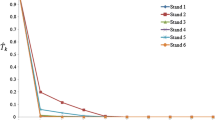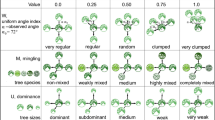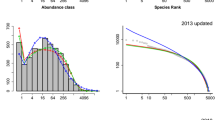Abstract
Testing how well Taylor’s law (TL) describes spatial variation of the population density of a species requires grouping sampling areas (patches of habitat) into blocks so that a mean and a variance of the population density can be calculated over the patches in each block. The relationship between specific groupings and TL remains largely unknown. Here, using tree counts from a deciduous forest, we studied the effect of four biological methods of grouping sampling areas into blocks on the form and parameters of TL. Regardless of the method of grouping, the species-specific basal area densities obeyed TL, and the estimated slopes were not significantly different from one grouping method to another. Surprisingly, TL remained valid when four kinds of randomizations were performed to the biological groupings and tree census. These randomizations randomly assigned sampling areas to blocks, and/or randomized the species composition within or across sampling areas. We found that the form of TL was robust to different grouping methods and species randomizations, but its parameter values depended significantly on species compositions at sampling areas.


Similar content being viewed by others
References
Arruda-Neto JDT, Bittencourt-Oliveira MC, Castro AC, Rodrigues TE, Harari J, Mesa J, Genofre GC (2012) Global warming and the power-laws of ecology. Atmos Clim Sci 2:8–13
Avery ET, Burkhart EH (2002) Forest measurements, 5th edn. McGraw-Hill, NY
Azevedo RBR, Leroi AM (2001) A power law for cells. Proc Natl Acad Sci USA 98:5699–5704
Bitterlich W (1984) The relascope idea: relative measurements in forestry. Commonwealth Agricultural Bureaux, Wallingford
Cohen JE (2013) Stochastic population dynamics in a Markovian environment implies Taylor’s power law of fluctuation scaling. Theor Popul Biol 93:30–37
Cohen JE, Xu M, Schuster WSF (2012) Allometric scaling of population variance with mean body size is predicted from Taylor’s law and density-mass allometry. Proc Natl Acad Sci USA 109:15829–15834
Cohen JE, Xu M, Schuster WSF (2013a) Stochastic multiplicative population growth predicts and interprets Taylor’s power law of fluctuation scaling. Proc R Soc B-Biol Sci 280:20122955
Cohen JE, Xu M, Brunborg H (2013b) Taylor’s law applies to spatial variation in a human population. Genus 69(1):25–60
Dalin P, Kindvall O, Björkman C (2009) Reduced population control of an insect pest in managed willow monocultures. PLoS One 4(5):e5487
Green DM (2003) The ecology of extinction: population fluctuation and decline in amphibians. Biol Conserv 111:331–343
Gregoire TG, Valentine HT (2004) Sampling strategies for natural resources and the environment. Chapman and Hall/CRC, London
Hanski I (1980) Spatial patterns and movements in coprophagous beetles. Oikos 34:293–310
Hanski I (1982) On patterns of temporal and spatial variation in animal populations. Ann Zool Fenn 19:21–37
Hanski I (1987) Cross-correlation in population dynamics and the slope of spatial variance-mean regressions. Oikos 50:148–151
Isham V (1991) Assessing the variability of stochastic epidemics. Math Biosci 107(2):209–224
James A, Plank MJ (2007) unpublished paper, available at http://arxiv.org/pdf/0712.0613.pdf
Jiang J, DeAngelis DL, Zhang B, Cohen JE (2014) Population age and initial density in a patchy environment affect the occurrence of abrupt transitions in a birth-and-death model of Taylor’s law. Ecol Model 289:59–65
Jørgensen B (1987) Exponential dispersion models. J Roy Stat Soc B 49:127–162
Jørgensen B (1997) The theory of dispersion models. Chapman and Hall/CRC, London
Jørgensen B, Martínez JR, Vinogradov V (2009) Domains of attraction to Tweedie distributions. Lith Math J 49:399–425
Kaltz O, Escobar-Páramo P, Hochberg ME, Cohen JE (2012) Bacterial microcosms obey Taylor’s law: effects of abiotic and biotic stress and genetics on mean and variance of population density. Ecol Process 1:5
Keeling MJ, Grenfell BT (1999) Stochastic dynamics and a power law for measles variability. Philos Trans R Soc B-Biol Sci 354:769–776
Kendal WS (2002) A frequency distribution for the number of hematogenous organ metastases. J Theor Biol 217:203–218
Kendal WS (2004a) A scale invariant clustering of genes on human chromosome 7. BMC Evol Biol 4:3
Kendal WS (2004b) Taylor’s ecological power law as a consequence of scale invariant exponential dispersion models. Ecol Complex 1:193–209
Kendal WS, Jørgensen B (2011) Taylor’s power law and fluctuation scaling explained by a central-limit-like convergence. Phys Rev E 83:066115
Kilpatrick AM, Ives AR (2003) Species interactions can explain Taylor’s power law for ecological time series. Nature 422:65–68
Lai J, Yang B, Lin D, Kerkhoff AJ, Ma K (2013) The allometry of coarse root biomass: log-transformed linear regression or nonlinear regression? PLoS One 8(10):e77007
Legendre S, Schoener TW, Clobert J, Spiller DA (2008) How is extinction risk related to population-size variability over time? A family of models for species with repeated extinction and immigration. Am Nat 172:282–298
MathWorks Inc (2012) MATLAB R2012a. Natick, MA
McArdle BH (1988) The structural relationship: regression in biology. Can J Zool 66(11):2329–2339
McArdle BH, Gaston KJ, Lawton JH (1990) Variation in the size of animal populations: patterns, problems and artefacts. J Anim Ecol 59(2):439–454
McLaughlin JF, Hellmann JJ, Boggs CL, Ehrlich PR (2002) The route to extinction: population dynamics of a threatened butterfly. Oecologia 132:538–548
Packard GC, Birchard GF (2008) Traditional allometric analysis fails to provide a valid predictive model for mammalian metabolic rates. J Exp Biol 211:3581–3587
Packard GC, Birchard GF, Boardman TJ (2011) Fitting statistical models in bivariate allometry. Biol Rev 86:549–563
Perry JN (1981) Taylor’s power law for dependence of variance on mean in animal populations. J Roy Stat Soc C-Appl 30:254–263
Ramsayer J, Fellous S, Cohen JE, Hochberg ME (2011) Taylor’s Law holds in experimental bacterial populations but competition does not influence the slope. Biol Lett 8:316–319
Reschke C (1990) Ecological communities of New York State. New York Natural Heritage Program. New York State Department of Environmental Conservation, Latham, NY
SAS Institute (2010) JMP 9. Cary, NC
Sawyer AJ (1989) Inconstancy of Taylor’s b: simulated sampling with different quadrat sizes and spatial distributions. Res Popul Ecol 31:11–24
Schoener TW, Spiller DA (1992) Is extinction rate related to temporal variability in population size? An empirical answer for orb spiders. Am Nat 139:1176–1207
Schuster WSF, Griffin KL, Roth H, Turnbull MH, Whitehead D, Tissue DT (2008) Changes in composition, structure and aboveground biomass over seventy-six years (1930–2006) in the Black Rock Forest, Hudson Highlands, southeastern New York State. Tree Physiol 28:537–549
Smith RJ (2009) Use and misuse of the reduced major axis for line-fitting. Am J Phys Anthropol 140(3):476–486
Taylor LR (1961) Aggregation, variance and the mean. Nature 189:732–735
Taylor LR (1984) Assessing and interpreting the spatial distributions of insect populations. Annu Rev Entomol 29:321–357
Taylor LR, Woiwod IP, Perry JN (1978) The density-dependence of spatial behavior and the parity of randomness. J Anim Ecol 47:383–406
Taylor LR, Perry JN, Woiwod IP, Taylor RAJ (1988) Specificity of the spatial power-law exponent in ecology and agriculture. Nature 332:721–722
Vucetich JA, Waite TA, Qvarnemark L, Ibargüen S (2000) Population variability and extinction risk. Conserv Biol 14:1704–1714
Xiao X, White EP, Hooten MB, Durham SL (2011) On the use of log-transformation vs. nonlinear regression for analyzing biological power laws. Ecology 92:1887–1894
Xu C-Y, Turnbull MH, Tissue DT, Lewis JD, Carson R, Schuster WSF, Whitehead D, Walcroft AS, Li J, Griffin KL (2012) Age-related decline of stand biomass accumulation is primarily due to mortality and not to reduction in NPP associated with individual tree physiology, tree growth or stand structure in a Quercus-dominated forest. J Ecol 100:428–440
Yamamura K (1990) Sampling scale dependence of Taylor’s power law. Oikos 59:121–125
Zar JH (2009) Biostatistical analysis, 5th edn. Pearson, London
Acknowledgments
We thank Kevin Gaston, Allon Klein, Roy Malka, Michael Plank, and Sabrina Russo for helpful comments; Priscilla K. Rogerson for assistance; and the US National Science Foundation for grants EF-1038337 and DMS-1225529.
Conflict of interest
The authors state that they have no conflict of interest in this work.
Author information
Authors and Affiliations
Corresponding author
Electronic supplementary material
Below is the link to the electronic supplementary material.
Rights and permissions
About this article
Cite this article
Xu, M., Schuster, W.S.F. & Cohen, J.E. Robustness of Taylor’s law under spatial hierarchical groupings of forest tree samples. Popul Ecol 57, 93–103 (2015). https://doi.org/10.1007/s10144-014-0463-0
Received:
Accepted:
Published:
Issue Date:
DOI: https://doi.org/10.1007/s10144-014-0463-0




